镀锌镁铝生产线设备与工艺流程
镀锌车间工艺流程及生产注意事项

镀锌车间工艺流程及生产注意事项一、生产工艺流程1、酸洗黑料穿挂根据规格和长度不同,分为单头吊挂和平吊挂。
2、穿挂好的材料进入酸池进行酸洗,根据材料的规格和表面腐蚀程度不同,确定酸洗时间;酸池侧面和一端通过酸雾吸收塔吸收车间酸雾,提高车间的空气质量。
3、、酸洗质量达标的材料,为保证酸洗好的镀件尽量少的将铁离子和酸带入助镀池,转入清水池进行两次清洗,定期使用两个水池循环保证清水池水的PH值和铁离子保持在正常范围内,溢出的水进入污水处理系统处理后二次利用。
4、清洗完成的材料进入助镀池进行助镀,不同规格的材料助镀时间不同,调整好助镀池的工艺参数保证其助镀效果。
5、助镀完成的材料,调往炉前的烘干平台上,使其表面进一步快速干燥,避免锌液飞溅,进入锌锅浸镀时间根据材料的规格不同时间、温度都不同,浸镀时产生大量的含锌废气通过布袋除尘器吸收,以此减少空气中的烟尘含量。
6、浸镀完成后进入冷却池进行冷却,为了能够快速的把温度快速降下来,冷却水的温度通过冷却塔上的一个PLC编程自动装置把上限控制在40℃。
7、冷却完成后进入钝化池进行钝化,使材料表面能够快速有效的形成一层钝化膜,防止在梅雨季节材料表面形成一种碱式碳酸锌的白色粉末,加快镀层的腐蚀。
8、钝化完成的材料,对材料的质量首先自检,对不良品直接返镀,对符合国家标准的小面积的漏铁进行修复,滴瘤、毛刺、堵孔、处理至合格。
二、生产安全1、设备镀锌车间最多的设备就是行车,所以首先对行车的钢丝绳、吊钩要经常检查,特别是酸洗工序的行车受酸雾腐蚀的影响,吊钩上的卡簧很容易腐蚀掉,导致吊重物时吊钩滑出;其中容易超载的就是进料行车和下池翻料行车,首先是控制进料的重量,再是要经常关注这两台行车有没有除吊钩、钢丝绳以外的其他配件是否存在异样;再就是两台镀锌行车因为在镀锌是行车前后摆动的比较厉害,所以大轮、变速箱磨损比较快,因为了之后行车就无法启动,很容易导致镀件的变色,甚至整挂料返镀,要定期检查,并及时的更换。
热镀锌处理线的工艺流程以及相关设备描述

热镀锌处理线的工艺流程以及相关设备描述热镀锌处理线的工艺流程以及相关设备描述随着世界经济的发展,市场对于钢板的热镀锌需求数量日益增多,同时对于钢板的热镀锌质量要求也越来越高,这就对热镀锌处理线的工艺水平要求越来越严格,所以,近些年对于热镀锌钢板的连续退火技术的工艺要求以及相关设备有了明显的改善。
文章针对热镀锌生产线的工艺流程及处理方法,以及连续退火炉相关设备的组成作简要说明。
1、热镀锌连续退火技术发展简析随着世界经济的发展,工业生产水平的日益进步,市场对于钢板防腐性能的要求逐渐提高,钢板防腐已成为工业生产中重要的研究方向,采用带钢表面进行金属镀层的方法防止带钢腐蚀,其金属镀层原料来源广泛,具有较强的成本优势,广泛应用于工业生产中。
当前工业生产中最为普遍的金属镀层方位有电镀法和热镀法。
镀锌板用途广泛,主要应用于环境较为恶劣的户外,所以对镀层的厚度有着较高的要求。
另外,金属镀层相当于带钢表面产生阳极保护,镀层厚度增加将延长钢板使用寿命,此时对镀层均匀性的要求不是很严格,热镀锌产品正好能够满足以上要求。
传统的电镀锌尽管镀层较为均匀,表面没有明显缺陷,同钢板紧密结合,其厚度相当于普通热镀锌厚度的1/5至1/7,但其成本相对较高,市场使用较少。
目前,常见的钢板镀金属方法仍是热镀锌。
从上世纪30年代,波兰人森吉米尔发明的连续热镀锌技术被沿用至今,具有其自身较为独特的工艺方法。
其特点是通过采用直火加热的方法将带钢表面油脂烧掉,并使带钢表面发生氧化,之后在还原气氛中通过此用辐射管间接加热的方式,对带钢进行加热处理,将之前的氧化膜取出,是带钢表面活化,以合适的温度进入锌锅,完成带钢表面的镀锌。
2、生产工艺2.1 工艺流程热镀锌生产工艺流程:冷轧卷→开卷机→五辊矫直机→测厚仪→双层切头剪→半自动窄搭接焊机→清洗段→入口活套→连续退火炉→锌锅→气刀→小锌花或合金化炉→镀后冷却段→镀层测厚仪→水淬槽→热风干燥→光整机→拉矫机→化学处理→热风干燥→出口活套→静电涂油→卷取机。
钢管热镀锌生产线技术操作规程

钢管热镀锌生产线技术操作规程一、前言钢管热镀锌生产线是用于生产热镀锌钢管的重要设备,其操作规程对于保证生产质量、提高生产效率至关重要。
本文将详细介绍钢管热镀锌生产线的技术操作规程,以便操作人员能够严格按照规程进行操作,确保生产过程安全、稳定、高效。
二、设备准备1. 在进行生产前,需要对钢管热镀锌生产线进行全面的检查和维护,确保设备处于良好的工作状态。
检查包括但不限于设备的润滑情况、电气设备的接线是否松动、防护装置是否完好等。
2. 检查工作场地的环境卫生情况,清理杂物和易燃易爆物品,确保生产场地整洁、安全。
3. 确保所有操作人员已经接受了相关的安全培训,了解设备的操作规程和安全注意事项。
三、生产操作1. 启动设备前,先进行空载试运转,确保设备运转正常、无异常声音和振动。
2. 对于不同规格的钢管,需要根据生产要求调整设备的参数,包括热镀锌温度、镀锌速度等。
3. 在进行热镀锌生产时,操作人员需严格按照工艺要求进行操作,确保镀层的厚度和均匀性。
4. 定期对设备进行检查和维护,及时处理设备的故障和异常情况,确保设备的稳定运行。
5. 在生产过程中,严格遵守安全操作规程,禁止在设备运行时进行维修和调整。
四、质量控制1. 对于生产出的热镀锌钢管,需要进行严格的质量检验,包括外观质量、镀锌层厚度、镀层附着力等。
2. 对于不合格品,需要进行及时处理和记录,找出问题的原因并进行改进。
3. 对于合格品,需要进行包装、标识和入库,确保产品质量符合标准要求。
五、安全防护1. 在操作钢管热镀锌生产线时,操作人员需要严格遵守安全操作规程,穿戴好安全防护用具,确保人身安全。
2. 对于设备的安全防护装置,需要经常进行检查和维护,确保其完好有效。
3. 对于设备的电气部分,需要定期进行检查和维护,确保电气设备的安全可靠。
六、总结钢管热镀锌生产线技术操作规程对于保证生产质量和安全生产至关重要。
操作人员需要严格按照规程进行操作,确保设备的稳定运行、产品质量的稳定。
镀锌镁铝生产线设备与工艺流程

镀锌镁铝生产线设备与工艺流程下载温馨提示:该文档是我店铺精心编制而成,希望大家下载以后,能够帮助大家解决实际的问题。
文档下载后可定制随意修改,请根据实际需要进行相应的调整和使用,谢谢!并且,本店铺为大家提供各种各样类型的实用资料,如教育随笔、日记赏析、句子摘抄、古诗大全、经典美文、话题作文、工作总结、词语解析、文案摘录、其他资料等等,如想了解不同资料格式和写法,敬请关注!Download tips: This document is carefully compiled by theeditor. I hope that after you download them,they can help yousolve practical problems. The document can be customized andmodified after downloading,please adjust and use it according toactual needs, thank you!In addition, our shop provides you with various types ofpractical materials,such as educational essays, diaryappreciation,sentence excerpts,ancient poems,classic articles,topic composition,work summary,word parsing,copy excerpts,other materials and so on,want to know different data formats andwriting methods,please pay attention!镀锌镁铝生产线设备与工艺流程一、准备工作阶段。
在进行镀锌镁铝生产线的施工之前,需要做好充分的准备工作。
铝镀锌工艺流程

铝镀锌工艺流程
《铝镀锌工艺流程》
铝镀锌工艺是一种常用的表面处理工艺,用于保护铝制品免受腐蚀和氧化。
下面是铝镀锌工艺的基本流程:
1. 表面处理:首先,铝制品需要经过表面处理,包括除油、清洗和去除氧化层等步骤。
这些步骤是为了确保表面光洁,以便镀锌时有更好的附着力。
2. 防腐涂层:在表面处理后,铝制品需要进行一层防腐涂层的处理。
这一层涂层可以有效地保护铝制品不受腐蚀。
3. 热浸镀锌:接下来,铝制品需要进行热浸镀锌的处理。
这是将铝制品浸入加热的锌液中,使得表面形成均匀的锌层。
这一步骤不仅可以增加铝制品的耐腐蚀性能,而且可以提高其机械强度。
4. 精细加工:最后,镀锌后的铝制品需要进行精细加工,包括打磨、抛光等步骤,以使其表面更加光滑和亮丽。
总的来说,铝镀锌工艺流程包括表面处理、防腐涂层、热浸镀锌和精细加工。
这些步骤可以使铝制品具有更好的耐腐蚀性能和更美观的外观。
全自动镀锌生产线
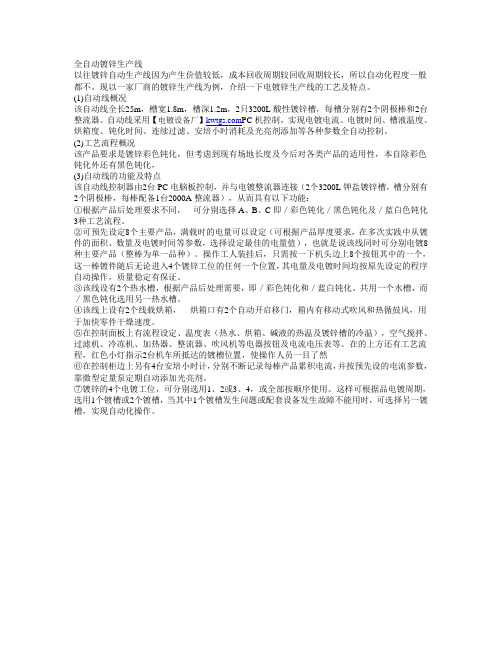
全自动镀锌生产线以往镀锌自动生产线因为产生价值较低,成本回收周期较回收周期较长,所以自动化程度一般都不。
现以一家厂商的镀锌生产线为例,介绍一下电镀锌生产线的工艺及特点。
(1)自动线概况该自动线全长25m,槽宽1.8m,槽深1.2m,2只3200L酸性镀锌槽,每槽分别有2个阴极棒和2台整流器。
自动线采用【电镀设备厂】 PC机控制,实现电镀电流。
电镀时间、槽液温度、烘箱度、钝化时间、连续过滤、安培小时消耗及光亮剂添加等各种参数全自动控制。
(2)工艺流程概况该产品要求是镀锌彩色钝化,但考虑到现有场地长度及今后对各类产品的适用性,本自除彩色钝化外还有黑色钝化,(3)自动线的功能及特点该自动线控制器由2台PC电脑板控制,并与电镀整流器连接(2个3200L钾盐镀锌槽,槽分别有2个阴极棒,每棒配备1台2000A整流器),从而具有以下功能:①根据产品后处理要求不同,可分别选择A、B、C即/彩色钝化/黑色钝化及/蓝白色钝化3种工艺流程。
②可预先设定8个主要产品,满载时的电量可以设定(可根掘产品厚度要求,在多次实践中从镀件的面积、数量及电镀时间等参数,选择设定最佳的电量值),也就是说该线同时可分别电镀8种主要产品(整棒为单一品种)。
操作工人装挂后,只需按一下机头边上8个按钮其中的一个,这一棒镀件随后无论进入4个镀锌工位的任何一个位置,其电量及电镀时间均按原先设定的程序自动操作,质量稳定有保证。
③该线设有2个热水槽,根据产品后处理需要,即/彩色钝化和/蓝白钝化。
共用一个水槽,而/黑色钝化选用另一热水槽。
④该线上设有2个线载烘箱,烘箱口有2个自动开启移门,箱内有移动式吹风和热循鼓风,用于加快零件干燥速度。
⑤在控制面板上有流程设定、温度表(热水、烘箱、碱液的热温及镀锌槽的冷温),空气搅拌、过滤机、冷冻机、加热器、整流器、吹风机等电器按钮及电流电压表等。
在的上方还有工艺流程,红色小灯指示2台机车所抵达的镀槽位置,使操作人员一目了然⑥在控制柜边上另有4台安培小时计,分别不断记录每棒产品累积电流,并按预先设的电流参数,靠微型定量泵定期自动添加光亮剂。
镀铝锌工艺流程

镀铝锌工艺流程镀铝锌工艺流程是一种广泛应用于金属表面防腐蚀的工艺,能够有效地提高金属材料的耐蚀性。
下面我们来详细介绍一下镀铝锌的工艺流程。
首先,要进行镀铝锌的工艺流程,首先需要准备好所需的材料和设备。
常用的设备包括酸洗槽、中和槽、清洗槽、电镀槽等。
第一步是预处理。
金属表面处理是确保镀层质量的重要环节。
对于金属材料,首先要进行酸洗处理。
将金属材料浸入酸洗液中,并进行机械搅拌,去除表面的氧化物和污垢。
然后将金属材料放入中和槽中,中和槽的作用是使金属表面的酸和碱进行中和,以避免对后续工艺产生不良影响。
第二步是清洗处理。
将经过预处理的金属材料放入清洗槽中,进行清洗以去除表面残留的酸碱和杂质。
清洗槽中会加入溶剂和清洗剂,常用的溶剂有净水和酒精,常用的清洗剂有碱性清洗剂和酸性清洗剂。
清洗时间一般为5-20分钟,可以根据具体情况进行调整。
第三步是电镀处理。
将清洗好的金属材料放入电镀槽中。
电镀槽中会放入含有铝锌离子的镀液。
通过电流的作用,将金属材料表面电镀成一层铝锌合金薄膜。
电镀时间一般为5-60分钟,可以根据所需镀层的厚度和持久性进行调整。
电镀液中的铝锌浓度、电流密度、温度等参数也会影响镀层质量,需要进行合理的调整。
第四步是后处理。
将经过电镀处理的金属材料放入烘干箱中进行烘干,去除表面的水分。
然后进行表面处理,例如喷涂、油漆等,以增加镀层的美观度和耐久性。
最后进行包装和检验,确保产品质量达到标准要求。
总结来说,镀铝锌的工艺流程包括预处理、清洗处理、电镀处理和后处理四个步骤。
通过这些步骤,可以有效地提高金属材料的耐腐蚀性,延长其使用寿命。
同时,也要注意控制各个环节的参数,确保产品质量达到标准要求。
热镀锌生产线方案
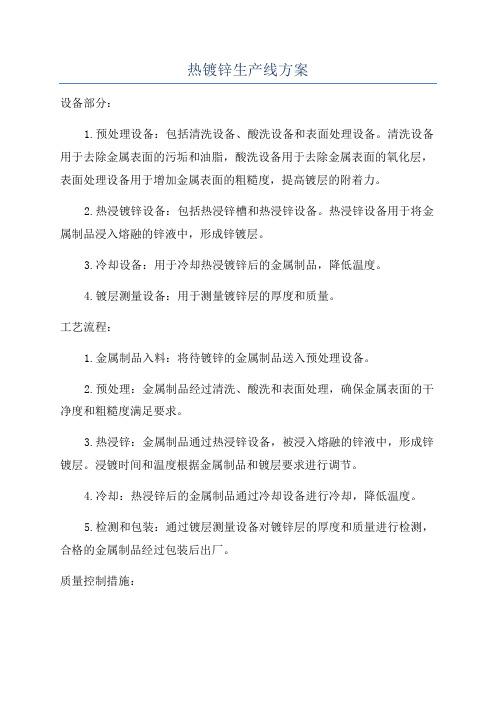
热镀锌生产线方案设备部分:1.预处理设备:包括清洗设备、酸洗设备和表面处理设备。
清洗设备用于去除金属表面的污垢和油脂,酸洗设备用于去除金属表面的氧化层,表面处理设备用于增加金属表面的粗糙度,提高镀层的附着力。
2.热浸镀锌设备:包括热浸锌槽和热浸锌设备。
热浸锌设备用于将金属制品浸入熔融的锌液中,形成锌镀层。
3.冷却设备:用于冷却热浸镀锌后的金属制品,降低温度。
4.镀层测量设备:用于测量镀锌层的厚度和质量。
工艺流程:1.金属制品入料:将待镀锌的金属制品送入预处理设备。
2.预处理:金属制品经过清洗、酸洗和表面处理,确保金属表面的干净度和粗糙度满足要求。
3.热浸锌:金属制品通过热浸锌设备,被浸入熔融的锌液中,形成锌镀层。
浸镀时间和温度根据金属制品和镀层要求进行调节。
4.冷却:热浸锌后的金属制品通过冷却设备进行冷却,降低温度。
5.检测和包装:通过镀层测量设备对镀锌层的厚度和质量进行检测,合格的金属制品经过包装后出厂。
质量控制措施:1.原材料质量控制:严格控制镀锌材料的成分和质量,确保锌液和金属制品的纯度。
2.工艺参数控制:根据金属制品和镀层要求,合理调节预处理、热浸锌和冷却设备的参数,确保镀锌层的厚度和质量。
3.检测控制:通过镀层测量设备对镀锌层的厚度和质量进行检测,及时调整工艺参数,确保符合要求的镀锌层。
4.预防控制:对设备进行定期维护和保养,确保设备的正常运行,避免因设备故障导致镀锌不均匀或厚薄不一的问题。
总结:热镀锌生产线是一种常见的金属表面处理工艺,通过预处理、热浸锌和冷却设备,可为金属制品提供有效的防腐蚀保护。
通过严格控制原材料质量、工艺参数和检测控制,可确保镀锌层的厚度和质量符合要求。
同时,定期维护和保养设备,可提高设备的稳定性和可靠性,确保生产线的正常运行。
这些措施有助于提高产品质量和生产效率,满足市场需求。
铝生产工艺技术操作规程

铝生产工艺技术操作规程
1. 目的
为了确保铝生产工艺技术操作的安全性和质量,规范操作流程,保证生产线持续稳定运转,特制定本规程。
2. 适用范围
本规程适用于所有从事铝生产工艺技术操作的人员。
3. 操作规程
3.1 操作前,操作人员应认真查看设备和工具的完好情况,确
保操作安全。
3.2 操作中,操作人员应戴好工作服、口罩、手套等防护用品,正确使用设备和工具。
3.3 操作结束后,操作人员应将设备和工具进行清洗和消毒,
并归位妥善保管。
3.4 如需更换设备或维修设备,必须按照操作规程进行操作,
保证安全。
4. 注意事项
4.1 如发现设备故障或异常情况,应及时汇报主管人员进行处理。
4.2 禁止在操作过程中抽烟、吃东西等与操作无关的行为。
4.3 操作人员应定期接受操作技能培训和安全知识培训,不断
提高自身操作水平和安全意识。
5. 处罚措施
对于违反本规程的操作行为,一经发现,将按照规定进行处理,并对相关责任人进行追责。
6. 附则
6.1 本操作规程由生产部门负责解释和修改。
6.2 本操作规程适用于本企业的铝生产工艺技术操作,其他操作规程另行制定。
6.3 本操作规程自发布之日起正式执行。
热镀锌生产线工艺流程

热镀锌生产线工艺流程
《热镀锌生产线工艺流程》
热镀锌是一种将钢铁制品表面镀上锌层的防腐处理工艺。
热镀锌生产线工艺流程是指在整个生产线上,钢铁制品经过一系列的处理和处理工艺,最终实现镀上锌层的过程。
首先,在热镀锌生产线上,钢铁制品需要经过表面准备的处理。
这一步骤通常包括对表面的去污、去油和去锈等处理,以确保后续的镀锌工序能够顺利进行。
接下来是热镀锌生产线上的热镀锌工序。
在这一步骤中,准备好的钢铁制品会被浸入熔化的锌液中,使锌液能够均匀地附着在钢铁表面上,形成一层防腐的镀锌层。
这不仅可以保护钢铁制品不受氧化和腐蚀的影响,还可以提高其使用寿命。
除了热镀锌工序外,热镀锌生产线还包括一系列的检测和涂层工序。
这些工序能够确保镀锌层的质量和均匀性,以及对钢铁制品进行一定的表面涂装,提高其美观性和耐久性。
最后,热镀锌生产线还需要对制品进行包装和储存,确保其在运输和使用过程中不受到外界环境的影响。
总的来说,《热镀锌生产线工艺流程》是一个包括多个环节的复杂工艺流程,需要严格的操作和严密的控制,才能生产出高质量的热镀锌钢材产品。
热镀锌线与工艺操作流程

热镀锌线与工艺操作流程一、入口段操作概述人口段的操作是要在保证作业线不停止作业的条件下将原板带钢连续地送入热镀锌机组。
入口的设备为双套布置,在生产中,一台生产而另一台那么处于准备状态。
例如,1#开卷机运行时,2#开卷机必须要上好钢卷,并用入口双层剪剪切去超厚的头部,做好焊接前的一切准备工作。
待1#开卷机的带钢运行完后,再切掉超厚的带钢尾部,迅速与2#开卷机上的准备好的钢卷头部焊接起来,这样,两台开卷机交替作用,轮换准备,不致于因带钢供给不上而引起整个镀锌机组降速或停机。
这些操作,必须在储存于入口活套内的带钢还没有用完的时间内进行。
焊接结束后,使进口段加速地以比工艺速度快地速度运转,重新使活套回到充满状态。
此外,活套内必须保持适当的张力。
还要检查原板的外表状态,当发现原板缺陷时,要采取相应的处理措施。
二、开卷开卷时首先用吊车将原料钢卷从存放区吊到入口鞍座上。
在入口鞍座上操作工要检查钢卷质量,如检查边裂情况和钢卷塔形情况,检查钢卷的标签是否与生产方案单相符。
符合要求后人工剪断带钢捆带,然后用入口钢卷小车将钢卷运送到开卷机卷筒上,上卷时要注意使钢卷的中心线与卷筒的中心线高度相同,以防止钢卷与卷筒的碰撞。
上卷后,降下钢卷小车,卷筒涨紧,通过目视操作入口钢卷对中装置使钢卷处于机组的中心线上。
压下压辊,升起穿带导板,点动开卷机和入口夹送辊使带头送到入口双层剪。
三、切头在冷轧带卷的头尾不可防止地要存在超厚局部,在开卷机出来的钢卷,用爬行速度送到双层剪进行剪切,剪下的废钢通过废料收集装置送到收集箱中。
这样依次逐张剪切,直到带钢厚度符合要求为止。
带钢尾部的超厚局部,在带钢尾部运行到上述切头后应到达的厚度时,也应该将余下的局部剪切掉。
假设是带钢头部没有超厚,切头时必须将钢卷外表损坏的一两圈剪掉。
假设发现头部还有边裂、孔洞等不适合于镀锌的缺陷,就还要继续剪切,直到符合要求为止。
四、焊接带钢经夹送辊后被送到焊机处,并和上一卷的带钢在焊机的入口和出口处建立了一个小的带钢活套,此后带钢的头部进入焊机。
镀锌车间工艺流程
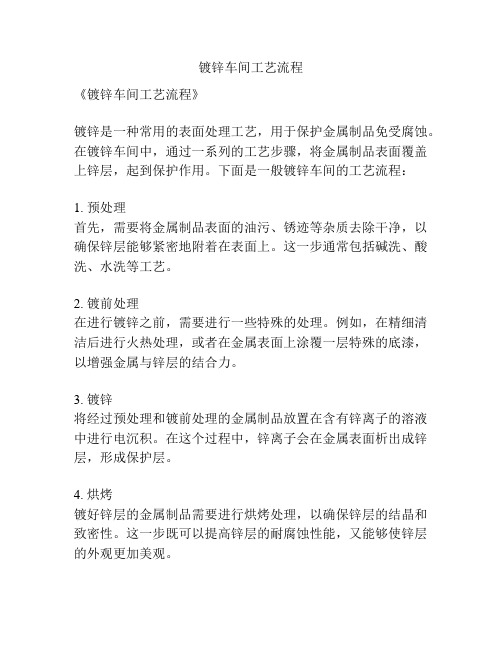
镀锌车间工艺流程
《镀锌车间工艺流程》
镀锌是一种常用的表面处理工艺,用于保护金属制品免受腐蚀。
在镀锌车间中,通过一系列的工艺步骤,将金属制品表面覆盖上锌层,起到保护作用。
下面是一般镀锌车间的工艺流程:
1. 预处理
首先,需要将金属制品表面的油污、锈迹等杂质去除干净,以确保锌层能够紧密地附着在表面上。
这一步通常包括碱洗、酸洗、水洗等工艺。
2. 镀前处理
在进行镀锌之前,需要进行一些特殊的处理。
例如,在精细清洁后进行火热处理,或者在金属表面上涂覆一层特殊的底漆,以增强金属与锌层的结合力。
3. 镀锌
将经过预处理和镀前处理的金属制品放置在含有锌离子的溶液中进行电沉积。
在这个过程中,锌离子会在金属表面析出成锌层,形成保护层。
4. 烘烤
镀好锌层的金属制品需要进行烘烤处理,以确保锌层的结晶和致密性。
这一步既可以提高锌层的耐腐蚀性能,又能够使锌层的外观更加美观。
5. 检测
最后,需要对镀锌后的产品进行各项质量检测,包括厚度检测、附着力测试、外观检查等。
确保产品达到相关的标准要求。
以上就是一般镀锌车间的工艺流程。
随着工艺技术的不断优化和进步,镀锌车间的工艺流程也在不断地完善和改进,以满足市场对高质量镀锌产品的需求。
镀锌线工艺段简介及硬件和程序的介绍

钝化阶段
在锌层表面涂覆一层保护膜, 以提高镀层的耐腐蚀性能。
烘干阶段
通过加热去除多余的水分,使 镀层更加稳定。
镀锌线的应用领域
01
02
03
建筑行业
用于制造钢结构、门窗、 栏杆等建筑部件的防腐蚀 保护。
交通工具
用于制造汽车、火车、船 舶等交通工具的零部件, 提高耐腐蚀性能。
五金制品
镀锌线的程序优化与改进
01
随着生产工艺的不断改进和技术的发展,镀锌线的控制程序也需要不 断进行优化和改进。
02
程序优化与改进的目的是提高生产效率、降低能耗、减少故障和提高 产品质量。
03
常见的优化与改进方向包括算法优化、设备联动控制、故障诊断与预 防等。
04
通过不断的技术创新和实践经验积累,可以逐步提升镀锌线控制程序 的性能和可靠性,为企业的生产和发展提供有力支持。
展望
未来镀锌线工艺段将朝着高效、环保、 智能化的方向发展,不断提高产品质 量和降低成本,以满足市场的不断变 化和需求。
THANKS
感谢观看
镀锌线的主要设备
锌锭
作为镀锌溶液的主要成分,其 质量和纯度对镀锌效果有重要 影响。
循环系统
包括泵和管道,用于使镀锌溶 液在镀槽内循环流动,保证溶 液温度和成分的均匀分布。
镀锌槽
用于盛装镀锌溶液,是整个镀 锌工艺的核心部分。
加热设备
用于维持镀锌溶液的温度,通 常采用电加热或蒸汽加热方式。
过滤设备
用于去除镀锌溶液中的杂质和 颗粒物,保持溶液的清洁度。
用于制造工具、刀具、餐 具等金属制品的表面防腐 处理。
镀锌线的优缺点
优点
镀锌层具有优良的耐腐蚀性能, 能够有效保护金属材料免受腐蚀 ;同时,镀锌工艺相对简单,成 本较低,适用于大规模生产。
镀锌车间工艺操作规程
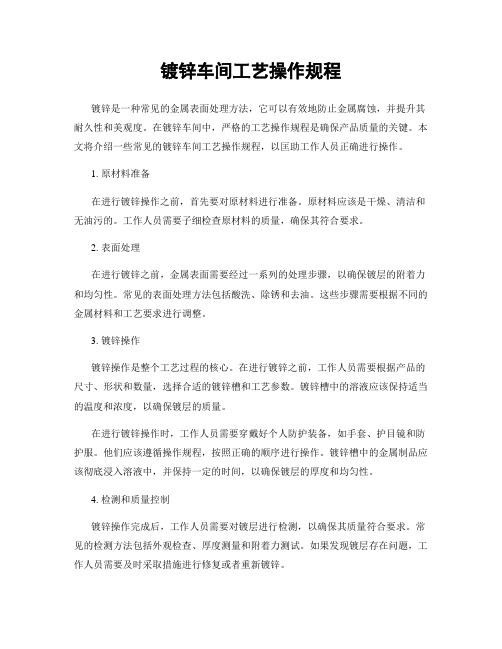
镀锌车间工艺操作规程镀锌是一种常见的金属表面处理方法,它可以有效地防止金属腐蚀,并提升其耐久性和美观度。
在镀锌车间中,严格的工艺操作规程是确保产品质量的关键。
本文将介绍一些常见的镀锌车间工艺操作规程,以匡助工作人员正确进行操作。
1. 原材料准备在进行镀锌操作之前,首先要对原材料进行准备。
原材料应该是干燥、清洁和无油污的。
工作人员需要子细检查原材料的质量,确保其符合要求。
2. 表面处理在进行镀锌之前,金属表面需要经过一系列的处理步骤,以确保镀层的附着力和均匀性。
常见的表面处理方法包括酸洗、除锈和去油。
这些步骤需要根据不同的金属材料和工艺要求进行调整。
3. 镀锌操作镀锌操作是整个工艺过程的核心。
在进行镀锌之前,工作人员需要根据产品的尺寸、形状和数量,选择合适的镀锌槽和工艺参数。
镀锌槽中的溶液应该保持适当的温度和浓度,以确保镀层的质量。
在进行镀锌操作时,工作人员需要穿戴好个人防护装备,如手套、护目镜和防护服。
他们应该遵循操作规程,按照正确的顺序进行操作。
镀锌槽中的金属制品应该彻底浸入溶液中,并保持一定的时间,以确保镀层的厚度和均匀性。
4. 检测和质量控制镀锌操作完成后,工作人员需要对镀层进行检测,以确保其质量符合要求。
常见的检测方法包括外观检查、厚度测量和附着力测试。
如果发现镀层存在问题,工作人员需要及时采取措施进行修复或者重新镀锌。
在整个工艺过程中,质量控制是非常重要的。
工作人员需要定期对设备和溶液进行检查和维护,确保其正常运行。
他们还需要记录每一批产品的工艺参数和检测结果,以便追溯和分析。
5. 环境保护镀锌车间应该注重环境保护。
工作人员需要正确处理废水、废气和废渣,以避免对环境造成污染。
他们应该按照像关法规和标准进行操作,并定期进行环境监测。
此外,工作人员还需要定期接受相关培训和技术更新,以提升自身的技能和知识水平。
他们应该关注行业的最新发展,了解新的工艺和设备,以提高工作效率和产品质量。
总结镀锌车间工艺操作规程是确保产品质量的关键。
热浸锌铝镁工艺流程

热浸锌铝镁工艺流程一、什么是热浸锌铝镁。
热浸锌铝镁呀,简单来说就是一种给金属材料穿上一层超级防护衣的方法。
它就像是给金属材料做了一个全方位的防护套餐。
这种工艺处理后的金属呢,会变得超级耐用,就像有了超能力一样。
你想啊,金属在外面风吹雨淋的,要是没有这种保护,那很快就会生锈或者被腐蚀得不成样子啦。
而热浸锌铝镁就能让金属在各种恶劣的环境里都能保持良好的状态。
这可是整个流程的第一步哦。
首先得挑选合适的金属材料,就像我们做菜得先选好食材一样。
这个金属材料要保证表面干净整洁,不能有太多的杂质或者油污之类的东西。
要是表面脏脏的,后面浸镀的时候就会出问题啦。
比如说有油污的话,那锌铝镁涂层可能就没办法很好地附着在金属表面上。
所以呢,在这个阶段,会对金属材料进行一系列的预处理,像脱脂、酸洗之类的操作。
脱脂就是把那些油脂去掉,酸洗则是把表面的一些锈迹或者氧化物给清除掉。
这就像是给金属材料洗了个澡,让它干干净净地准备接受下一个步骤。
这浸镀环节可是热浸锌铝镁工艺的核心部分哦。
把经过预处理的金属材料慢慢地放进锌铝镁的熔液里。
这就像把洗干净的小物件放进装满神奇魔法药水的大锅里一样。
这个熔液的温度可是很关键的,温度太高或者太低都会影响浸镀的效果。
如果温度太高,可能会让金属材料变形或者让涂层变得不均匀;要是温度太低呢,涂层可能就会太薄或者不完整。
在浸镀的过程中,金属材料在熔液里要停留合适的时间,就像泡澡不能泡太久也不能泡太短时间一样。
这个时间要恰到好处,这样才能保证金属表面均匀地裹上一层厚厚的锌铝镁涂层。
当金属材料从锌铝镁熔液里出来之后,它可是热乎着呢。
这时候就要进行冷却啦。
冷却的速度也有讲究哦。
如果冷却得太快,可能会导致涂层产生一些裂纹之类的缺陷;要是冷却得太慢呢,又可能会影响涂层的性能。
冷却之后,还不能就这么完事儿了,还得对浸镀后的金属进行一些后处理。
比如说进行一些表面的修整啊,检查涂层有没有缺陷之类的。
如果发现有小的缺陷,就得想办法修补一下,就像给金属材料的防护衣补补小破洞一样。
锌铝镁圆管生产工艺流程

锌铝镁圆管生产工艺流程英文回答:The production process of zinc-aluminum-magnesium round tubes involves several steps. First, the raw materials, including zinc, aluminum, and magnesium, are prepared in the desired proportions. These materials are then melted in a furnace at high temperatures.Once the metals have melted, they are carefully poured into a round mold, which is usually made of steel. The mold is designed to give the tube its desired shape and dimensions. After pouring the molten metal into the mold,it is left to cool and solidify.After the tube has solidified, it is removed from the mold and undergoes a process called heat treatment. This process involves subjecting the tube to high temperatures for a specific period of time. Heat treatment helps to improve the mechanical properties of the tube, such as itsstrength and hardness.Next, the tube is subjected to a process called surface treatment. This involves cleaning the surface of the tubeto remove any impurities or contaminants. The tube may also undergo additional treatments, such as polishing or coating, to enhance its appearance and protect it from corrosion.Once the surface treatment is complete, the tube is ready for further processing, such as cutting or shaping. This is often done using specialized machinery, such as a tube cutting machine or a tube bending machine. These machines can precisely cut or shape the tube according tothe desired specifications.After the tube has been cut or shaped, it may undergo additional processes, such as welding or assembly. These processes are often carried out to join multiple tubes together or to attach other components to the tube.Finally, the finished zinc-aluminum-magnesium round tubes are inspected for quality and packaged for shipment.They are then ready to be used in various applications, such as construction, automotive, or aerospace industries.中文回答:锌铝镁圆管的生产工艺流程包括几个步骤。
铝材厂生产线标准化流程
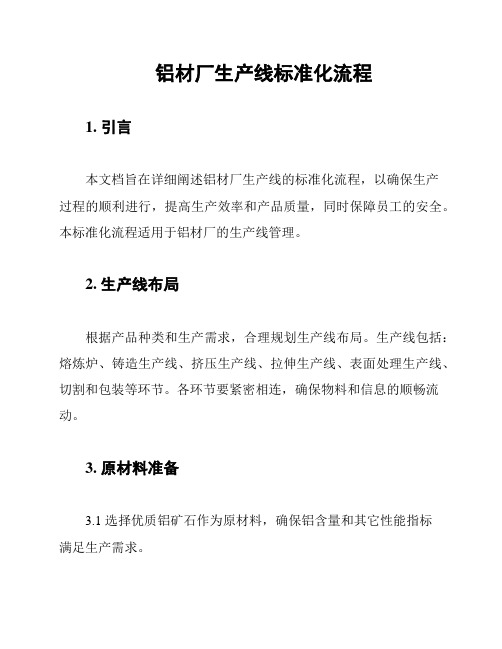
铝材厂生产线标准化流程1. 引言本文档旨在详细阐述铝材厂生产线的标准化流程,以确保生产过程的顺利进行,提高生产效率和产品质量,同时保障员工的安全。
本标准化流程适用于铝材厂的生产线管理。
2. 生产线布局根据产品种类和生产需求,合理规划生产线布局。
生产线包括:熔炼炉、铸造生产线、挤压生产线、拉伸生产线、表面处理生产线、切割和包装等环节。
各环节要紧密相连,确保物料和信息的顺畅流动。
3. 原材料准备3.1 选择优质铝矿石作为原材料,确保铝含量和其它性能指标满足生产需求。
3.2 铝矿石经过破碎、研磨等工序,制成氧化铝粉。
3.3 将氧化铝粉与燃料(如焦炭)进行混合,送入熔炼炉进行熔炼,生成铝液。
4. 熔炼炉操作4.1 检查熔炼炉设备,确保设备正常运行。
4.2 将铝矿石和燃料放入熔炼炉,启动加热设备,升温至熔点以上,使铝矿石熔化成铝液。
4.3 定期检测铝液的成分和温度,确保符合生产需求。
4.4 熔炼过程中,要注意炉内温度的控制,防止过高或过低。
5. 铸造生产线操作5.1 检查铸造生产线设备,确保设备正常运行。
5.2 将熔炼好的铝液倒入铸造模具中。
5.3 等待铝液冷却固化,取出铸件。
5.4 对铸件进行去毛刺、清洗等处理。
6. 挤压生产线操作6.1 检查挤压生产线设备,确保设备正常运行。
6.2 将铸件放入挤压模具中,加热至工作温度。
6.3 施加压力,使铸件变形成为所需形状。
6.4 卸载压力,取出挤压后的铝材。
7. 拉伸生产线操作7.1 检查拉伸生产线设备,确保设备正常运行。
7.2 将挤压后的铝材放入拉伸模具中。
7.3 拉伸模具对铝材进行拉伸,使其变薄、延长。
7.4 取出拉伸后的铝材,进行检查和处理。
8. 表面处理生产线操作8.1 检查表面处理生产线设备,确保设备正常运行。
8.2 将拉伸后的铝材进行表面处理,如阳极氧化、喷涂等。
8.3 检查表面处理质量,确保符合要求。
9. 切割和包装9.1 根据客户需求,对表面处理后的铝材进行切割、裁剪等加工。
镀锌生产线工艺流程
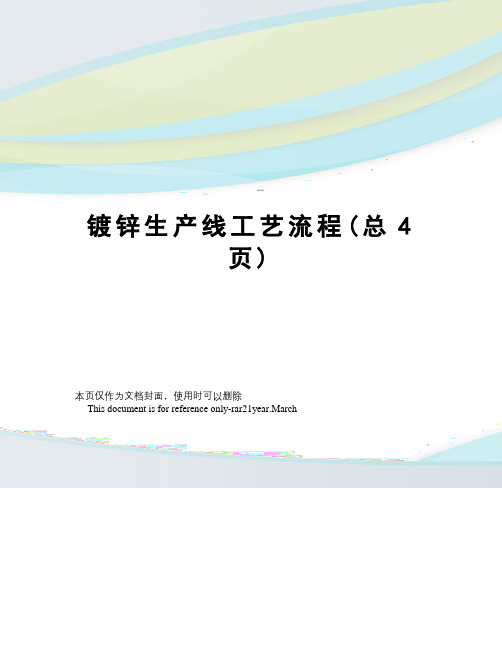
镀锌生产线工艺流程(总4页)本页仅作为文档封面,使用时可以删除This document is for reference only-rar21year.March镀锌生产线工艺流程开卷→焊接→前处理→入口活套→加热炉退火→锌锅→气刀→水淬→光整→拉矫→收卷开卷:即为上原料卷焊接:将前后钢带连接到一起前处理:将原料卷表面的油脂进行清洗用(用脱脂剂固体配置成【碱性2%】液体喷淋到钢板表面)入出口活套:储存钢带用,保证生产线连续运转加热炉:退火,使钢板便于加工(炉温500~800℃不等,保护气体是用NH3分解出来的NH混合气体,H2是用来燃烧还原用,N2是惰性气体,起到保护作用)锌锅:镀锌用气刀:刮锌用水淬:冷却钢板光整:对表面进行压光拉矫:矫正钢板板形收卷:下成品卷用彩涂生产线工艺流程开卷→连接→入口活套→前处理→钝化→初涂→初烘→精涂→精烘→出口活套→收卷→包装开卷:即为上原料钢卷,利用开卷机将原料钢钢卷打开。
连接机:将前、后钢带连接,保证原料进入下一道工序的连续性入出口活套:储存钢带用,保证生产线连续运转前处理:用自来水清洗板面(镀锌板)的灰尘钝化:增强油漆附着力用初涂初烘:涂底漆和背漆并烘干(烘干炉温度300-350℃左右)精涂精烘:涂面漆并烘干(烘干炉温度300-350℃左右)焚烧炉:将初烘炉和精烘炉稀释剂挥发份抽出经电加热催化剂催化燃烧,把热量重新回收送到炉内收卷:将纸套筒放置到收卷机上,人工将钢板卷边后,机器自动收卷开卷:即为上原料钢卷,利用开卷机将原料钢钢卷打开。
焊接:将前、后钢带连接,以保持原料进入下一道工序的连续性。
前处理:将脱脂剂【碱性2%】喷淋到原料钢板表面,清洗掉原料钢卷表面的油脂。
入出口活套:储存钢带用,保证生产线连续运转加热炉:炉温500~800℃不等,将钢板在经过加热炉的过程中,利用H2,将钢板表面的氧化铁还原(H2是NH3受热分解产生的,分解出的N2起到隔离空气的作用)。
- 1、下载文档前请自行甄别文档内容的完整性,平台不提供额外的编辑、内容补充、找答案等附加服务。
- 2、"仅部分预览"的文档,不可在线预览部分如存在完整性等问题,可反馈申请退款(可完整预览的文档不适用该条件!)。
- 3、如文档侵犯您的权益,请联系客服反馈,我们会尽快为您处理(人工客服工作时间:9:00-18:30)。
镀锌镁铝生产线设备与工艺流程英文回答:
The equipment and process flow of the galvanized magnesium aluminum production line are crucial in ensuring the quality and efficiency of the production. In this response, I will provide an overview of the equipment and process flow in both English and Chinese.
Equipment:
1. Degreasing tank: This tank is used to remove any grease or oil from the surface of the magnesium aluminum alloy before further processing. It typically consists of a heated tank with agitators to enhance the degreasing process.
2. Pickling tank: The pickling tank is used to remove any oxides or scales from the surface of the magnesium aluminum alloy. It usually contains an acid solution, such
as hydrochloric acid, which reacts with the oxides to facilitate their removal.
3. Flux tank: The flux tank is used to apply a flux solution onto the surface of the magnesium aluminum alloy. The flux helps to protect the metal from oxidation during the galvanization process.
4. Galvanizing tank: This tank is the main part of the production line, where the actual galvanization process takes place. The magnesium aluminum alloy is immersed in a molten zinc bath, which forms a protective zinc coating on its surface. The galvanizing tank is typically equipped with temperature control systems to ensure the proper temperature for the galvanization process.
5. Cooling tank: After the galvanization process, the magnesium aluminum alloy is transferred to a cooling tank. This tank is filled with water or other cooling agents to rapidly cool down the galvanized metal and solidify the zinc coating.
Process flow:
1. Degreasing: The magnesium aluminum alloy is first immersed in the degreasing tank, where any grease or oil is removed from its surface.
2. Pickling: The degreased alloy is then transferred to the pickling tank, where the oxides or scales are removed through the reaction with the acid solution.
3. Fluxing: The pickled alloy is then moved to the flux tank, where a flux solution is applied to its surface to protect it from oxidation during galvanization.
4. Galvanization: The fluxed alloy is finally immersed in the galvanizing tank, where it is coated with a layer of molten zinc. The alloy is carefully monitored to ensure the proper temperature and duration for the galvanization process.
5. Cooling: After galvanization, the coated alloy is transferred to the cooling tank, where it is rapidly cooled
down to solidify the zinc coating.
中文回答:
镀锌镁铝生产线的设备和工艺流程对于生产的质量和效率至关
重要。
在本回答中,我将以中英文提供设备和工艺流程的概述。
设备:
1. 脱脂槽,该槽用于将镁铝合金表面的油脂去除。
通常由加热
槽和搅拌器组成,以增强脱脂过程。
2. 酸洗槽,酸洗槽用于去除镁铝合金表面的氧化物或鳞片。
通
常含有酸性溶液,如盐酸,与氧化物反应以促进其去除。
3. 通量槽,通量槽用于在镁铝合金表面涂覆通量溶液。
通量有
助于在镀锌过程中保护金属免受氧化。
4. 镀锌槽,该槽是生产线的主要部分,实际进行镀锌过程的地方。
镁铝合金被浸入熔融的锌液中,在其表面形成一层保护性的锌
涂层。
镀锌槽通常配备温度控制系统,以确保镀锌过程的适当温度。
5. 冷却槽,镀锌过程后,镁铝合金被转移到冷却槽中。
该槽内充满水或其他冷却剂,以快速冷却镀锌金属并固化锌涂层。
工艺流程:
1. 脱脂,首先将镁铝合金浸入脱脂槽中,去除其表面的油脂。
2. 酸洗,然后将脱脂合金转移到酸洗槽中,通过与酸性溶液的反应去除氧化物或鳞片。
3. 通量处理,将酸洗合金移至通量槽中,在其表面涂覆通量溶液,以防止镀锌过程中的氧化。
4. 镀锌,最后将通量合金浸入镀锌槽中,涂上一层熔融锌。
镁铝合金在镀锌过程中需进行温度和时间的仔细监控。
5. 冷却,镀锌后的合金转移到冷却槽中,快速冷却以固化锌涂层。
